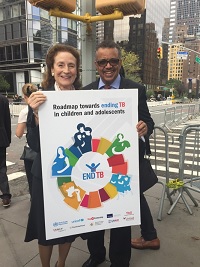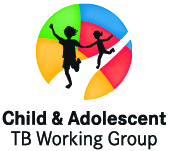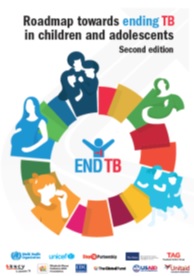What's New
2021 Virtual annual meeting
The annual meeting of the Child and Adolescent TB Working Group took place on the Zoom platform on Tuesday 30 November 2021. The meeting was open to all members of the working group representing a broad range of stakeholders including paediatricians, NTP managers and childhood TB focal points in the NTP, MCH representatives, technical and financial partners, community TB representatives and WHO staff from headquarters, regional and country offices.
The main purpose of the 2021 annual meeting was to provide a summary of the reviews presented to the WHO Guideline Development Group on the management of tuberculosis in children and adolescents in May/June 2021, both related to the PICO (Population, Intervention, Comparator, Outcome) questions related to diagnostic approaches, shortened treatment of drug-susceptible TB in children with non-severe disease, treatment of drug-resistant TB, treatment of drug-susceptible TB meningitis and models of care; as well as to the background questions on the socio-economic impact of TB on children and adolescents & the engagement of adolescents in TB care.
A total of 292 registrations were received, and 192 participants attended the meeting. The meeting was divided into two sessions of 2.5 hours each.
On behalf of Dr. Tereza Kasaeva, Director of the WHO Global TB Programme, Farai Mavhunga opened the meeting and warmly welcomed all participants. He referred to the disproportionate impact of the COVID-19 pandemic on TB prevention and case detection among children and adolescents, which will make it even more challenging to reach the UN High Level Meeting targets related to children. He conveyed that WHO is looking forward to close and continued collaboration with all relevant stakeholders at global, regional and national levels to implement the new recommendations and operational guidance in the guidelines and operational handbook. Kerri Viney then presented the detailed objectives of the meeting as well as the agenda. Farhana Amanullah, Chair of the Child and Adolescent TB Working Group, gave the report from the chair on the activities of the working group since the last meeting in October 2020. Annemieke Brands and Sabine Verkuijl from the WHO secretariat provided an update on the upcoming WHO policy recommendations relevant to children and progress towards UNGA HLM on TB targets, including an overview of data included in the Global tuberculosis report and database 2021.
During the second part of the first session, the main findings of several reviews conducted for the 2022 WHO consolidated guidelines were presented. Leslie Enane presented the main findings of the literature review as well as best practices on the background question on optimizing care for adolescents with TB infection or disease. Salla Atkins and Delia Boccia presented the main findings of the literature review on the socio-economic impact of TB on children, adolescents and their families. Nobu Nishikiori then shared the findings of the analysis of Patient Cost Surveys. At the end of the session, two WHO Civil Society Task Force members, Amir Khan from Pakistan and Blessi Kumar from India provided community perspectives and views on active case finding for tuberculosis and on optimizing care for children and adolescents affected by TB.
The second session of the meeting was divided in three parts. Part 1 focussed on evidence reviews underlying diagnostic approaches in children. Kenneth Gunasekera shared the outcome of the evaluation of existing treatment decision algorithms using an Individual Patient Data set and also mentioned the ongoing work related to two treatment decision algorithms that will be included in the 2022 WHO operational handbook to be published alongside the consolidated guidelines (early 2022). Alexander Kay shared the evidence from the systematic review on the use of Xpert Ultra in stool and gastric aspirate for the diagnosis of pulmonary TB in children. Grace Bolie from DRC provided implementation considerations related to diagnosis of tuberculosis in children from a programmatic perspective.
In the second part of the second session, Anna Turkova provided an update on the sub-analyses of the SHINE trial. Anthony Garcia-Prats shared the results from the systematic review and individual patient data meta-analysis of children and adolescents treated for RR/MDR-TB. Giorgia Sulis presented the evidence from the systematic review on the treatment of TB meningitis.
In the third and last part of the second session, Courtney Yuen, presented the evidence from the systematic review on models of care for child and adolescent TB (decentralized care and family-centred, integrated care for case detection and provision of TB preventive treatment). Martina Casenghi provided perspectives on models of care from the Unitaid-funded CaP-TB project and Eric Wobudeya shared perspectives on models of care from the Unitaid-funded TB-SPEED project.
In the closing session, the Secretariat thanked all presenters and participants and acknowledged the continuing financial support for the activities of the working group from USAID through UNOPS.
The meeting agenda, recordings and PDFs of the presentations can be accessed through the links below.
Link to recording (N.B. Please note that the recording starts a few minutes late):
Passcode: +RmD9!7V
Presentations
- 1. Farhana Amanullah_Chair_Update_2021 [.pdf]
- 10. Tony Garcia-Prats_paed DR-TB IPD [.pdf]
- 11. Giorgia Sulis_TB meningitis [.pdf]
- 12. Courtney Yuen_Models of Care [.pdf]
- 2. Annemieke Brands_Sabine Verkuijl_WHO updates [.pdf]
- 3. Nobu Nishikiori_TB patient cost surveys_Children and Adolescents [.pdf]
- 4. Salla Atkins_Delia Boccia_Socioeconomic impact TB [.pdf]
- 5. Leslie Enane_Adolescent TB [.pdf]
- 6. Amir Khan_Community perspective [.pdf]
- 7. Ken Gunasekera_Treatment decision algorithms [.pdf]
- 8. Alex Kay_Ultra in gastric aspirate_stool [.pdf]
- Scope and agenda_annual meeting_CAWG_Final [.pdf]
2020 Virtual annual meeting
The annual meeting of the Child and Adolescent TB Working Group took place on the Webex platform on Friday, 16 October 2020. The meeting was open to all members of the working group representing a broad range of stakeholders including paediatricians, NTP managers and childhood TB focal points in the NTP, MCH representatives, technical and financial partners, community TB representatives and WHO staff from headquarters, regional and country offices. The main purpose was to maintain a vibrant child and adolescent TB community, share country experiences in scaling up the response to child and adolescent TB and to discuss next steps to move the agenda forward. A total of 260 registrations were received, and 192 participants attended the meeting. The meeting was divided into two sessions of 2.5 hours each.
The meeting was opened by Dr. Tereza Kasaeva, the Director of the WHO Global TB Programme, who highlighted recent developments in data on child and adolescent TB, paediatric TB drug optimization and the process of updating the guidelines on the management of TB in children and adolescents. Farhana Amanullah gave the report from the chair on the activities of the working group since the last meeting in October 2019. Annemieke Brands and Sabine Verkuijl from the secretariat provided an update on new WHO policy recommendations relevant to children and progress towards UNGA HLM on TB targets, including an overview of new data included in the Global tuberculosis report 2020.
Karen du Preez from the Desmond Tutu TB Centre at Stellenbosch University presented on an interdisciplinary and multi-level approach to estimate the disease burden and outcomes of childhood tuberculous meningitis (TBM). The main findings of the SHINE trial (Shorter Treatment for Minimal Tuberculosis in Children), a phase III randomised open trial comparing 4 versus 6 months treatment in children (+/- HIV) with smear-negative non-severe TB in Africa and India, were presented by Aarti Avinash Kinikar and Priyanka Raichur. This was followed by an update on paediatric TB prevention trials by Anneke Hesseling. James Seddon then presented a selection of interesting peer-reviewed articles.
In the second part of the meeting, Edine Tiemersma and Endale Mengesha Goshu shared country experiences with the implementation of the Simple One Step stool processing method for Xpert MTB/RIF from Ethiopia and Vietnam. After this, Chishala Chabala presented on emerging experiences with diagnostic approaches in children with HIV, severe pneumonia and malnutrition from the TB-Speed project. Laura Olbrich then presented on T-cell marker-based assays for the diagnosis of tuberculosis in children and adults.
The next session focused on systematic reviews on the risk of TB after exposure and on TB screening in children, with presentations by Leo Martinez and Bryan Vonasek. The last session covered the impact of COVID-19 on child and adolescent TB services, with experiences from Ghana by Anthony Enimil and from the Americas by Celia Martinez. Unfortunately, Rahab Mwaniki could not connect to present on community perspectives on COVID and TB, but her presentation is available on the website.
In the closing session, the Secretariat acknowledged the continuing financial support from USAID through UNOPS.
Meeting Report, Meeting Recording
Presentations
- 01. Farhana Amanullah_Chair_Update_DRAFT_02.10.20 [.pdf]
- 02. Video_Family TB-COVID [.mp4]
- 03. Annemieke_Sabine_WHO_Updates [.pdf]
- 04. Karen DuPreez_TBM research project overview [.pdf]
- 05. SHINE Trial Results [.pdf]
- 06. Anneke Hesseling_TPT trial [.pdf]
- 07. James Seddon_Important Papers 2019-2020 [.pdf]
- 08. KNCV_SOS_StoolTesting [.pdf]
- 09. Chishala Chabala_TB-Speed_Experience_NPA&stool [.pdf]
- 10. Laura Olbrich_RaPaed_TAMTB [.pdf]
- 11. Leo Martinez_SystematicReview_Risk of TB [.pdf]
- 12. Bryan Vonasek_Child TB Screening [.pdf]
- 13. Antony Enimil_COVID_Child-adoTB_Africa [.pdf]
- 14. Celia Martinez_TB-COVID Americas [.pdf]
- 15. Rahab Mwaniki_Impact of COVID 19 on TB programming [.pdf]
- AnnualMeetingChildAdolescentTBWG_2020_Report_FINAL [.pdf]
Roadmap towards ending TB in children and adolescents (French)
First paediatric antituberculosis drug optimization (PADO TB 1) meeting, February 2019
Building on the experience in the WHO HIV programme, the inaugural paediatric antituberculosis drug optimization (PADO TB 1) meeting, which took place on 14 and 15 February 2019 at WHO headquarters in Geneva, aimed to establish a formal transparent process to reach evidence-based consensus among a variety of stakeholders regarding priority antituberculosis drugs and formulations for children. The meeting was attended by 45 participants, with six additional attendees participating remotely, and included representatives from NTPs from TB high burden and priority countries, clinicians, scientists, funding organizations, international organizations and technical partners.
During the first day, presentations covered the size and specifics of the paediatric anti-TB drug market, the concept of paediatric antituberculosis drug optimization, experiences with antituberculosis drug development and market-shaping and the current adult and paediatric TB research and clinical trial landscape, priorities and overview of drug development. Participants engaged in discussions on the PADO for TB mechanism and modus operandi in the context of complementary efforts in paediatric drug optimization as well as the process to reach consensus on short/medium and long-term priorities for the development of paediatric antituberculosis drugs and formulations.
On the second day, after providing additional background information on the PADO for HIV processes and priority list, participants broke up into three groups to discuss short/medium and long term priorities for a) treatment of drug-susceptible TB; b) treatment of drug-resistant TB; and c) treatment of latent TB infection (LTBI – both drug-susceptible [DS-TB] and drug-resistant TB [DR-TB]). A summary of the agreed priorities can be found in executive summary of the meeting report. This prioritization exercise was an important step towards development of and access to the most effective and safest medications in affordable, child-friendly formulations needed to reach the UN General Assembly High Level Meeting on TB targets for treatment and prevention in children.
The Sentinel project updated their Field Handbook to provide implementation advice on the new WHO Guidelines for Multi-Drug and Rifampin-Resistant Tuberculosis (available at https://www.who.int/tb/publications/2018/WHO.2018.MDR-TB.Rx.Guidelines.prefinal.text.pdf). This Field Handbook was developed by a global team of pediatric DR-TB experts, including several Child and Adolescent TB Working Group members and aims to provide practical advice for practitioners, programmes and policy makers on how the new WHO recommendations can be used to improve treatment for children with DR-TB. For more information on the Sentinel project, visit http://sentinel-project.org/.
Committing to ending TB in children, adolescents and families, 24 September 2018

On the eve of the 73rd UN General Assembly, UNICEF, WHO and the Stop TB Partnership hosted a side-event to show commitment and accelerate action towards ending TB in children, adolescents and families. Co-sponsored by the Permanent Mission of Japan to the United Nations, the Danish Ministry of Health, the Permanent Mission of Nigeria to the United Nations, TB Alliance, Louder Than TB, Treatment Action Group, Unitaid, the Global Fund, USAID, Elizabeth Glaser Pediatric AIDS Foundation, JHPIEGO, The Union, KNCV Tuberculosis Foundation and Every Woman Every Child, the event aimed to show commitment and accelerate action towards ending TB in children, adolescents and families. Leaders and people affected by TB discussed the importance of targeted commitments for children and adolescents. During the event the new Roadmap towards ending TB ieventn children and adolescents was launched as well as two accompanying documents: Best practices on child and adolescent TB care; and, Research priorities for paediatric tuberculosis.
- Agenda of the event on "Committing to ending TB in children, adolescents and families" on 24 September 2018 in New York, USA
- Pictures of the launch
- Social media kit
- Roadmap towards ending TB in children and adolescents
- Best practices in child and adolescent TB care
- Research priorities for paediatric tuberculosis
Logo for the Child and Adolescent TB Working Group
As of September 2018, the Child and Adolescent TB Working Group has their own logo.



